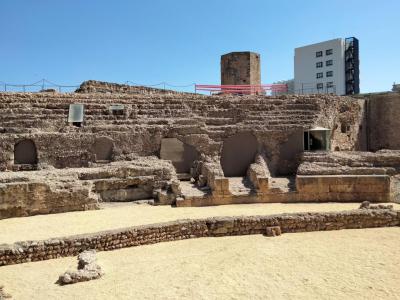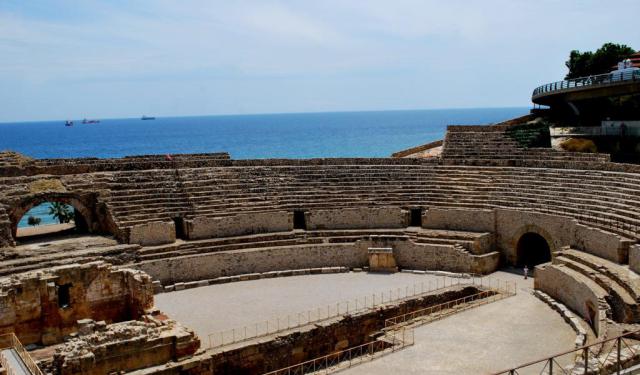
Circ Roma (Roman circus), Tarragona
The Roman Circus stands as a captivating archaeological site that transports visitors back in time to the grandeur of ancient Roman entertainment and civic life. This well-preserved structure is a testament to the engineering prowess and cultural sophistication of the Roman Empire, showcasing the significance of Tarraco, the ancient Roman name for Tarragona, as a regional hub.
Constructed in the 1st century AD, the Roman Circus was primarily used for chariot races, a popular and thrilling spectacle in Roman society. The layout of the circus follows a traditional Roman design, featuring an elongated racetrack with semicircular ends, known as the spina, and tiered seating for spectators. The arena could accommodate thousands of enthusiastic onlookers who gathered to witness the exhilarating races and other public events.
The remnants of the Roman Circus offer a vivid glimpse into the scale and structure of the original circus. The elongated track, marked by well-preserved barriers and central spina, provides insight into the logistics of chariot races and the grandeur of the events held here. The spectator stands, arranged in a horseshoe shape, showcase the Romans' architectural ingenuity in optimizing sightlines for the audience.
The Roman Circus also served broader civic and social functions beyond chariot races. It was a multifunctional space used for public gatherings, religious ceremonies, and other communal events. The circus played a central role in the social and cultural life of Tarraco, reflecting the Roman emphasis on public entertainment and communal bonding.
Today, the site is carefully preserved, allowing modern visitors to walk through the remnants of the Roman Circus. Interpretative displays and informational signage contribute to a richer understanding of the historical context and significance of this archaeological gem.
Constructed in the 1st century AD, the Roman Circus was primarily used for chariot races, a popular and thrilling spectacle in Roman society. The layout of the circus follows a traditional Roman design, featuring an elongated racetrack with semicircular ends, known as the spina, and tiered seating for spectators. The arena could accommodate thousands of enthusiastic onlookers who gathered to witness the exhilarating races and other public events.
The remnants of the Roman Circus offer a vivid glimpse into the scale and structure of the original circus. The elongated track, marked by well-preserved barriers and central spina, provides insight into the logistics of chariot races and the grandeur of the events held here. The spectator stands, arranged in a horseshoe shape, showcase the Romans' architectural ingenuity in optimizing sightlines for the audience.
The Roman Circus also served broader civic and social functions beyond chariot races. It was a multifunctional space used for public gatherings, religious ceremonies, and other communal events. The circus played a central role in the social and cultural life of Tarraco, reflecting the Roman emphasis on public entertainment and communal bonding.
Today, the site is carefully preserved, allowing modern visitors to walk through the remnants of the Roman Circus. Interpretative displays and informational signage contribute to a richer understanding of the historical context and significance of this archaeological gem.
Want to visit this sight? Check out these Self-Guided Walking Tours in Tarragona. Alternatively, you can download the mobile app "GPSmyCity: Walks in 1K+ Cities" from Apple App Store or Google Play Store. The app turns your mobile device to a personal tour guide and it works offline, so no data plan is needed when traveling abroad.
Circ Roma (Roman circus) on Map






Sight Name: Circ Roma (Roman circus)
Sight Location: Tarragona, Spain (See walking tours in Tarragona)
Sight Type: Attraction/Landmark
Guide(s) Containing This Sight:
Sight Location: Tarragona, Spain (See walking tours in Tarragona)
Sight Type: Attraction/Landmark
Guide(s) Containing This Sight:
Walking Tours in Tarragona, Spain
Create Your Own Walk in Tarragona
Creating your own self-guided walk in Tarragona is easy and fun. Choose the city attractions that you want to see and a walk route map will be created just for you. You can even set your hotel as the start point of the walk.
Roman Ruins Walking Tour
The city of Tarraco, the capital of the Hispania Tarraconensis province, held significant prominence within the vast Roman Empire. The remnants of those days, concentrated in the heart of Tarragona, are the pivotal historical sites that contribute to its UNESCO World Heritage status.
Indeed, the city's acclaim largely stems from its Roman ruins, notably the 2nd-century AD Roman... view more
Tour Duration: 2 Hour(s)
Travel Distance: 2.9 Km or 1.8 Miles
Indeed, the city's acclaim largely stems from its Roman ruins, notably the 2nd-century AD Roman... view more
Tour Duration: 2 Hour(s)
Travel Distance: 2.9 Km or 1.8 Miles
Tarragona Introduction Walking Tour
Nestled in the southern part of Catalonia, Spain, Tarragona is a coastal city boasting an abundance of ancient Roman ruins, rolling mountains, and magnificent beaches.
Shrouded in myth and mystery, Tarragona carries a name whose origins remain debated—linked to figures like Tarraho or Tearcon the Ethiopian, a seventh-century BC pharaoh. Its true founding date is also obscured in time.
... view more
Tour Duration: 2 Hour(s)
Travel Distance: 2.7 Km or 1.7 Miles
Shrouded in myth and mystery, Tarragona carries a name whose origins remain debated—linked to figures like Tarraho or Tearcon the Ethiopian, a seventh-century BC pharaoh. Its true founding date is also obscured in time.
... view more
Tour Duration: 2 Hour(s)
Travel Distance: 2.7 Km or 1.7 Miles


